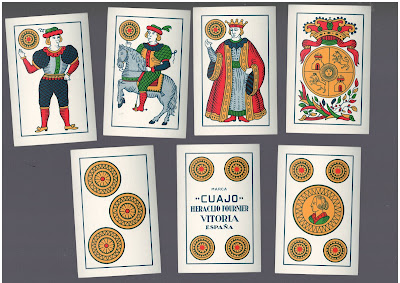Now we come to a curious version of the Spanish pattern ( see here and here) used in the Philippines. This particular example was made in the 1970s ( from an inscription found among the cards of the deck) by the Spanish company Fournier
Spanish playing cards are still used ( albeit to a small extent) in the Philippines. This is not surprising from a nation that was colonized by Spain for over three centuries. Images of people using what are clearly Los Dos Tigres cards in the Philippines can be seen on the net, as well as videos of people participating in a curious gambling game called Sakla. This involves a full deck of Spanish playing cards. For a Fillipino's thoughts on playing cards in his country, see here https://libertadfilipinas.wordpress.com/2014/12/19/lost-filipino-culture-playing-cards-ii/
The most unusual feature of the deck is its structure. The deck has four suits, like most Spanish decks; but instead of the full 12 cards in each suit, there are only seven, viz;
King, Knight, Valet, 4, 3,2 Ace,
This unit is repeated four times, to give a full deck of 128 cards. Observant readers may note that this structure is identical to the Chinese Si Se Pai, --four units of 28 cards each ( see here and here)
The nature of the game played with this deck bears this out ( As pointed out on Pagat.com's page on Cuajo ). There are only two acceptable "runs" in this game; King, Knight, Knave, and 5, 4, and 3. This corresponds to the melds of 将士相 and 車馬炮 in Se Se pai. Rules for the game may be found here
The nature of the game played with this deck bears this out ( As pointed out on Pagat.com's page on Cuajo ). There are only two acceptable "runs" in this game; King, Knight, Knave, and 5, 4, and 3. This corresponds to the melds of 将士相 and 車馬炮 in Se Se pai. Rules for the game may be found here
The suit of cups. One of the hings that strikes me is the sheer vividness of the color. The deep indigo blue, the vibrant orange, etc. This pattern preserves the "AHI VA" of the Los dos Tigres deck, found on the Knight of cups. On the 5 of cups is written "CORTES TABLA"
The second thing to note is the absence of index numbers, which are otherwise found in Spanish decks. Nonetheless, the "Pinta" (Pattern of breaks in the frame indicating the suit) are still present.
The suit of coins. It is surprising to note that the ace of coins still bears the arms of Castile and Leon. The five of coins bears a profile of a woman. The four of coins bears the maker's name.
The suit of swords. The ace of swords bears the inscription "CORTE TABLA", which is also found on the five of cups. The slight longitudinal curvature of the cards is especially evident in this photograph. They are made out of a particularly fine material; almost resembling plastic.
Three views of the wrapper. The cards are made by Fournier of Spain ( who has made several decks already featured on this blog). It is interesting to note that the deck is explicitly identified as "Cuajo Fillipino" perhaps indicating that the cards were solely made for export?
The back of the cards, and a warranty slip.






No comments:
Post a Comment